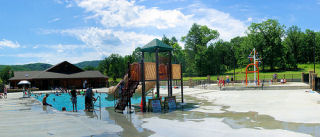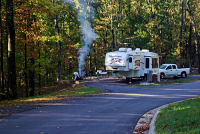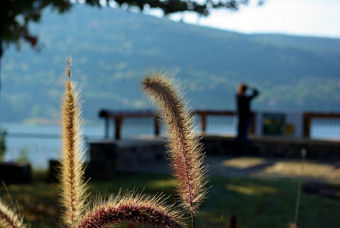Haw Creek
Camping, Travel, and More...
RV Manufacturers:
- Motor Coaches and Class A Motorhomes
- Class B Motorhomes and Vans
- Class C Motorhomes
- Fifth Wheel Trailers
- Travel Trailers
- Tear Drop Trailers
- Tent and Folding Trailers
- Truck Campers
- Off Road RVs
- Arkansas
- Montana
Contact Form at the Haw Creek blog
Arkansas Places – Arkansas Images
 Lake Fort Smith State Park
-
The State Park that Moved.
Lake Fort Smith State Park
-
The State Park that Moved.
See more photos of the park in the Lake Fort Smith Photo Gallery.
Located in a wooded valley in the Boston Mountains of the Arkansas Ozarks, the 259 acre Lake Fort Smith State Park reopened in the late Spring of 2008 four miles north of its original location, which was closed in early January, 2002. As a park reborn, with totally new facilities, it has 30 camp sites, a group lodging facility, picnic sites, a pavilion, marina with rental boats, a double lane boat ramp, a swimming pool, playground, and an 8,000 square foot visitor center with exhibit gallery, gift shop, a meeting/class room, a patio with an outdoor wood burning fireplace, and a great view of the lake and mountains. Activities for visitors include camping, fishing, kayaking, canoeing, backpacking, boating, hiking and mountain biking. The park borders lands of the Ozark National Forest.
Getting There
Online directions to the park, in many instances, will take you to the original site, not the new location. The park is located just off Scenic Highway 71, eight miles north of Mountainburg, Arkansas. Those traveling I-540 can get to Mountainburg from Exit 29. The closest exit to the park is actually the Chester exit. If you use this exit, follow the signs to Scenic Highway 71 and then turn north (left) on 71. The park entrance is just a short distance down the road on the right.
Swimming
 Swimming and skiing are not permitted in Lake Fort Smith. Swimming is
available at the park's 2,660 square foot swimming pool, which also has a wading
pool and splash pad. The 2250 square foot bathhouse includes changing areas,
lockers and a snack bar.
Swimming and skiing are not permitted in Lake Fort Smith. Swimming is
available at the park's 2,660 square foot swimming pool, which also has a wading
pool and splash pad. The 2250 square foot bathhouse includes changing areas,
lockers and a snack bar.
Trails
Inside the park is the western end of the Ozark Highlands Trail, which stretches about 165 miles across Arkansas to Buffalo National River, passing through some of the most remote and scenic parts of the Ozarks, including hills, hollows and bluffs and past numerous waterfalls. Other hiking and mountain bike trails within the new park are planned or under construction.
 Lodging
Lodging
The only lodging currently available in the park is the group lodge. It can accommodate up to 16 people in each wing. The lodge has a great room between the two dormitory wings and a kitchenette. Contact the park at 479-369-2469 to make reservations.
Cabins are to be added to the park later as funding is available.
Camping
The park has 30 camp sites. Twenty have 50 amp electrical service, water and sewer hookup. Ten have 30 amp electrical service and water. All sites have a woods view.
 Contact the park at 479-369-2469 to make reservations.
Contact the park at 479-369-2469 to make reservations.
Programs
Park programs are offered throughout the year, including hiking and backpacking workshops, boating and kayaking courses, and other courses, workshops, and classes in such diverse areas as birding and wildlife, nature photography, art, journaling, safety and survival, outdoor ethics, and outdoor cooking. Other programs include guided hikes, nature talks, lake tours and demonstrations throughout the park as well as the visitor center. Groups may request special programs to meet specific interests.
Park History
The original Lake Fort Smith State Park began a municipal and county park as
part of a 1930s project by the federal Work Projects Administration (WPA). The
WPA built dams for two reservoirs, Lake Fort Smith and Lake Shepherd Springs, in
the valley upstream of Mountainburg, to serve as part of the municipal water
supply system for the City of Fort Smith. A 95 acre recreational park, the
 Mountainburg Recreational Facility, was developed by Fort Smith and Crawford
County along Frog Bayou below the Lake Fort Smith dam. The WPA project
contributed a wading pool, a large swimming pool with two diving towers, four
stone veneer cottages, a new road, an arched bridge, a boat house, bridle paths,
and landscaping. WPA workers cleared brush and built barbeque pits and
stone tables as well as rock houses around the mountain springs.
Mountainburg Recreational Facility, was developed by Fort Smith and Crawford
County along Frog Bayou below the Lake Fort Smith dam. The WPA project
contributed a wading pool, a large swimming pool with two diving towers, four
stone veneer cottages, a new road, an arched bridge, a boat house, bridle paths,
and landscaping. WPA workers cleared brush and built barbeque pits and
stone tables as well as rock houses around the mountain springs.
The State of Arkansas took over administration of the park in 1967. The pool, which used untreated water directly from Lake Fort Smith, had been closed for health reasons since 1964. Arkansas State Parks built a new Olympic sized pool, remodeled the bathhouse and concession stand, added new playground equipment and constructed a small campground. The park reopened in 1973 as Lake Fort Smith State Park.
With a planned construction of a larger Lake Fort Smith dam that would be built over part of the park, Lake Fort Smith State Park closed in January, 2002, to be relocated to a new site along the shores of the lake. The western trailhead of the Ozark Highlands Trail was relocated to Dockery Gap.
The original Fort Smith Lake Park Dam was retained in place to ensure a continuous water supply for Fort Smith during construction. Built over the site of the swimming pool and the visitor center, the new dam used the original dam for part of its base and is 101 feet higher than its predecessor. The construction joined Lake Fort Smith and Lake Shepherd Springs into a single, larger 1400 acre reservoir. Normal pool level for Lake Fort Smith was raised from 825 feet above sea level to 911 feet, with a capacity of approximately 2.75 billion gallons, triple that of the original reservoirs.
About 500 acres between the two original lakes had to be acquired for the new reservoir. Two historic cemeteries were relocated as were the remains of Native Americans unearthed during construction. Nine hundred feet of the Lake Shepherd Springs dam was demolished.
Lake Fort Smith State Park was relocated to the west side of the new reservoir, at the site of the Lake Shepherd Springs dam. The portion of the dam that was retained is now part of the park's day use area.
The City of Fort Smith, owner of the park, funded replacement of the original facilities. The State of Arkansas, which leases the land for the state park, paid for additional improvements. The new park buildings incorporate the rustic beauty reminiscent of old WPA buildings with native stonework, vaulted ceilings, wood-paneled walls, and massive wooden beams. Some stones from the old park were used.
Related Links:
- Lake Fort Smith State Park - Arkansas State Park website
- Area Information - Crawford County
- Ozark Highlands Trail - Ozark Highlands Trail Association (OHTA)